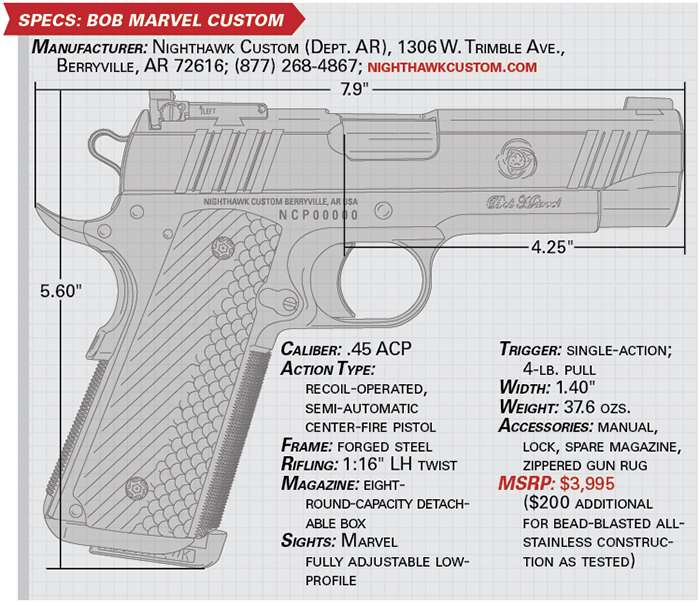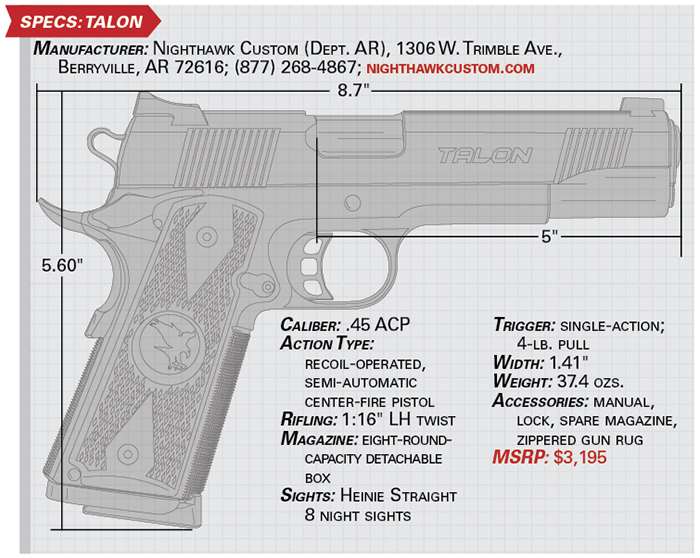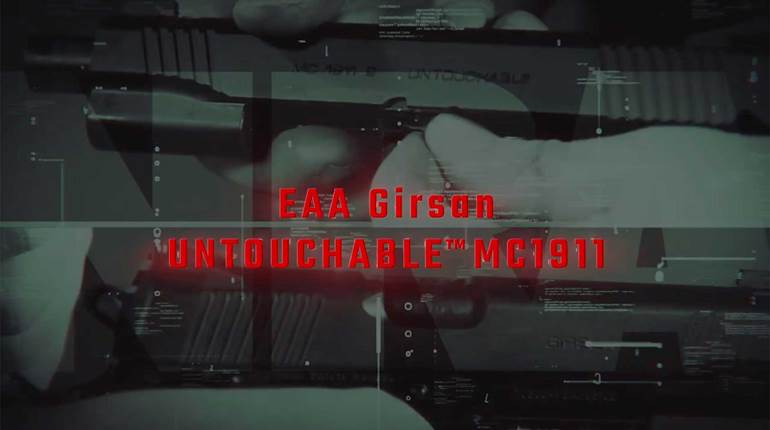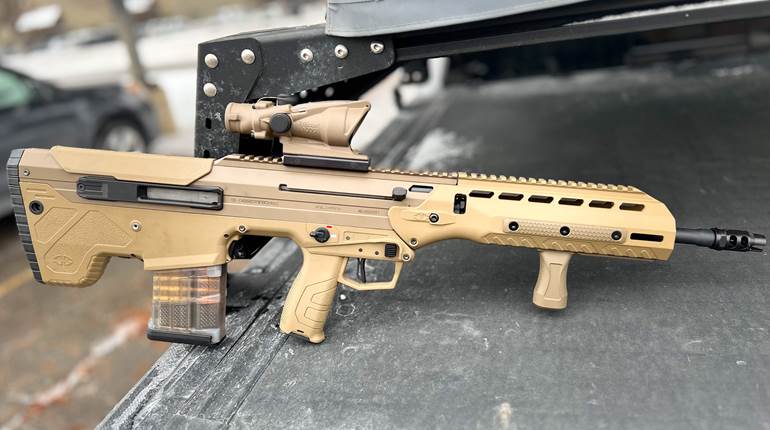
Although completely different in personality, the Nighthawk Talon (r.) and Bob Marvel Custom (far r.) feature the thoughtful touches and artisan-like attention to hand work for which the company has become so well-known.
Long years have passed since the patents for the M1911 pistol expired. Any builder may produce the gun as long as it satisfies federal statutes as a manufacturer. That, and the gun’s popularity, explain why so many makers crowd the field and why such a wide variety of grades is available. There is demand not only for average-price-point models but also for .45s in the high-end range. I don’t mean custom pistolsmiths building up highly specialized guns on otherwise plain platforms or from disparate parts, but rather companies that create guns from the keel up as elite fighting tools. Such a firm is Nighthawk Custom of Berryville, Ark.
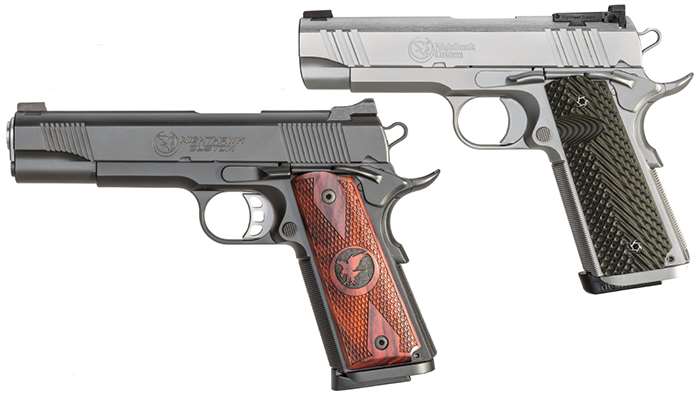
Built around a corps of advanced pistolsmiths, Nighthawk dates back to 2004. The company’s first guns were pretty straightforward M1911s in several chamberings, with—not surprisingly—the perennial .45 ACP chambering being the most common. Early in the life of the company, I reported on Nighthawk’s guns from the perspective that it was the new kid on the M1911 block (February 2006, p. 64). It was a rewarding experience, and I came to respect the personable, professional crew that built a great line of pistols. The fact that those early Nighthawks were scary accurate didn’t hurt, either. I was therefore pleased when this assignment allowed me to revisit the 10-year-old Nighthawk line via guns made just recently. The company now has a couple dozen models, but chose to send me a representative pair of guns for testing, both .45 ACPs. The first was a Talon model, which is an enhanced version of the basic M1911 service pistol. The second was the somewhat more refined Bob Marvel Custom model, which is a 4¼", all-stainless steel, bushingless-barrel gun. Let’s delve into that one first.
Nighthawk management persuaded well-known pistolsmith/designer Bob Marvel to not only write the specifications for a high-end M1911 pistol, but also to train one of its already-competent staff members to produce this exceptional gun. As with all Nighthawk Custom pistols, the build is carried out from beginning to end by one smith and begins with a receiver CNC machined in-house from a forging—in this case a stainless steel one. Add to that internal parts machined from bar stock and you begin to understand why these guns are of such a high order of quality. To all this, the Bob Marvel gun adds a specifically designed stainless steel slide and bushingless bull barrel along with unique sights and synthetic grips. There are other features we need to examine closely as well.
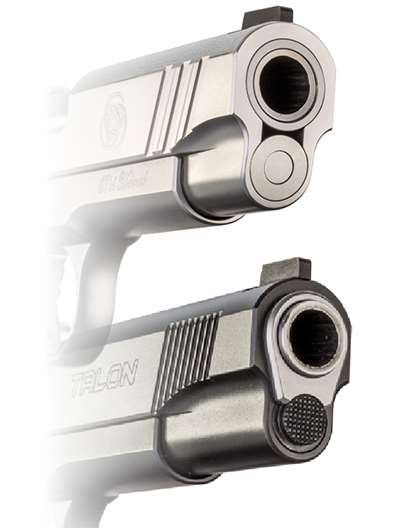
The pistol’s upper differs from the standard in several significant ways. As a fighting gun, the Bob Marvel Custom employs functional sights that are as low-profile and snag-resistant as possible. Fitted with tritium inserts, they consist of a front post and a rear of the precisely adjustable Bo-Mar type once commonly seen on NRA Bullseye pistols. To protect that broad rear sight face from the knocks of in-the-field handling, the sight actually sits a bit forward on the slide. Between the two sights, the surface is stippled and has a French border at the edges. Cocking serrations are at both the front and rear of the slide, rendered in an unusually lengthy yet narrow bar pattern. Also of note, the slide does not have a barrel bushing, but does have a full-length guide rod. It’s mounted on Marvel’s own recoil-spring system. For swift handling, the lower edges of the slide are carefully beveled to dehorn them. Finally, the lower front corner of the slide gets a sort of radiused rearward bevel called a “bull-nosed” system. This may be just cosmetic, but it would surely ease re-holstering.
The Bob Marvel Custom’s receiver is typical M1911-style, and thus familiar to the eye and hand of generations of American shooters. The designer fitted out the receiver with a number of refined touches. Many of today’s handgunners use their firearms in competitions that require shooting and reloading under the pressure of a clock. They’ve found out that an extended or funneled magazine well can speed up the process. Various kinds of devices of this type are on lots of guns, but the one on the Bob Marvel Custom is simple and effective. When you tap out the pin and remove the mainspring housing, the magazine well comes with it. It is a one-piece unit, checkered on the mainspring housing area and sporting a rounded entry to the magazine well that speeds magazine changes. The gun has matching checkering on the frontstrap. It comes with aggressively checkered G10 stocks that have an ovalized recess to the rear of the magazine catch. The shooter’s thumb naturally falls into the relieved area.
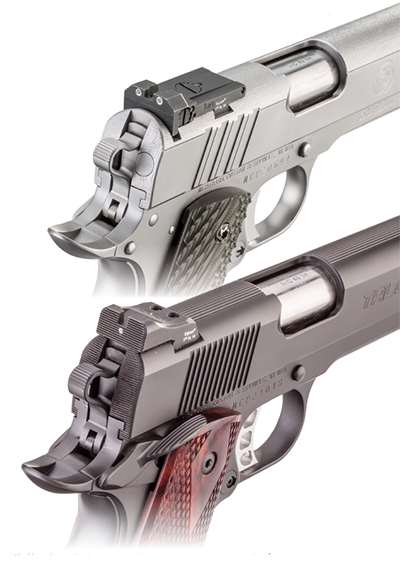
Controls on this classy version of the old workhorse are remarkably plain—and that’s good. The trigger is aluminum and has an adjustable overtravel stop. To the rear, there is a slightly extended beavertail safety with the inevitable memory pad at the bottom end. The hammer is skeletonized, and the thumb safety sports a slightly extended contact pad. I was personally taken with the slide lock, as it has a unique contour. Many makers seem to feel that this simple part needs to be radically re-shaped, usually by extending it rearward. The Bob Marvel Custom has a restrained concave lower surface, which might be useful in those rare occasions when the slide lock becomes a tactical control. It’s appealing, as is the gun as a whole. But we need to take a similar look at the other Nighthawk .45 pistol.
The Talon model would seem a lot more familiar to the doughboys of World War I and G.I.s of World War II. The sample gun was in blued carbon steel and wore a dull, businesslike finish. It features a full-size, 5" barrel with a conventional bushing and recoil spring plug arrangement—no guide rod. While it has a more businesslike character, this gun is far from being a plain-Jane, basic G.I. model. It has a host of upgraded features, and describing them will once again begin with the slide.
The sights have top-notch tritium inserts, a useful tool in low-light situations, and are from Heinie. They are of that company’s proprietary Straight 8 design that has the shooter vertically align the dot on the front sight with a matching dot below the rear sight notch. Between the two sights, there is a panel of lengthwise serrations, cut deeply into the steel. This is done to reduce the possibility of glare when the shooter is working hard to group his shots tightly. By the same reasoning, Nighthawk carefully cuts similar lateral serrations into the rear face of the slide to match the ones on the back of the rear sight. While this upper is pretty conventional, it does have cocking serrations both fore and aft. They are of the racy, angled, Gold Cup-type.
To a crisply machined receiver, Nighthawk installs a set of upgraded controls, including a bilateral safety with matching paddles on both sides of the gun. Talons also have a modern beavertail grip safety with memory pad and a conventional slide lock. The trigger is extended and made of aluminum, with a trio of lightening holes and an adjustable overtravel stop. The Talon has a high cut at the junction of the trigger guard and frontstrap, which is nicely checkered all the way down to the toe of the grip. The same checkering textures the mainspring housing. The Talon is like the Marvel Custom in that it has an extended magazine well. The unit is made in two pieces, but they’re joined and mounted to the gun nearly seamlessly. The maker chose old-fashioned wood with laser-cut checkering and the Nighthawk logo for the grips. I can’t help but notice than they retain a hint of the old double-diamond pattern—a nice touch. As a matter of fact, there are nice touches all over this pistol, as well as on its more costly stablemate.
That attention to detail is evidence that somebody who knew what he was doing looked at every single surface, edge, radius and corner. Rarely do you see such consistency as is exhibited in the Nighthawks. Look at the front edge of the receiver at the end of the so-called “dust cover.” Rather than an absolute square corner, this pistol is cut with a perfect, 45-degree bevel. It’s the same all over the gun, including the lower edges of the slide.

Internally, we find the same level of attention to detail. On both surveyed Nighthawks, the fit of slide to frame was excellent. It was also evident that the fitting of the proprietary barrel had received a lot of attention. A modern M1911 pistol uses the same basic design that John Browning developed a century past. Browning designed his parts to be fitted rather loosely, knowing the circumstances to which the pistol would be subjected. In the interest of greater accuracy, Nighthawk, like most modern makers, tightens up these tolerances. The moving pistol barrel must return to the same position relative to the sights every time it is fired. Barrel fit at muzzle, underlugs and hood must be precise. There are other spots in the gun that need careful attention, such as the trigger/sear/hammer relationship. The feed ramp is equally important. Nighthawk ’smiths addressed all of those points.
Before we look at the two guns in action, we need to dry-fire them a few times. Both pistols have very good, clean trigger pulls that break right at 4 lbs. on a Lyman trigger pull gauge.
At the range, I fired several magazines of mixed ammunition to determine the quality of the two Nighthawks in the functional sense. Functioning was 100 percent with no malfunctions. Note that both pistols were all-steel guns in the old traditional fashion. The various systems used to make M1911 pistols lighter and smaller assuredly have their place in the scheme of things, but a protracted shooting session is not one of them. Handheld, both pistols were easy to shoot. More weight means quicker recovery from shot to shot. It was only when each gun had a session with a Ransom machine rest that a full appreciation could be formed.
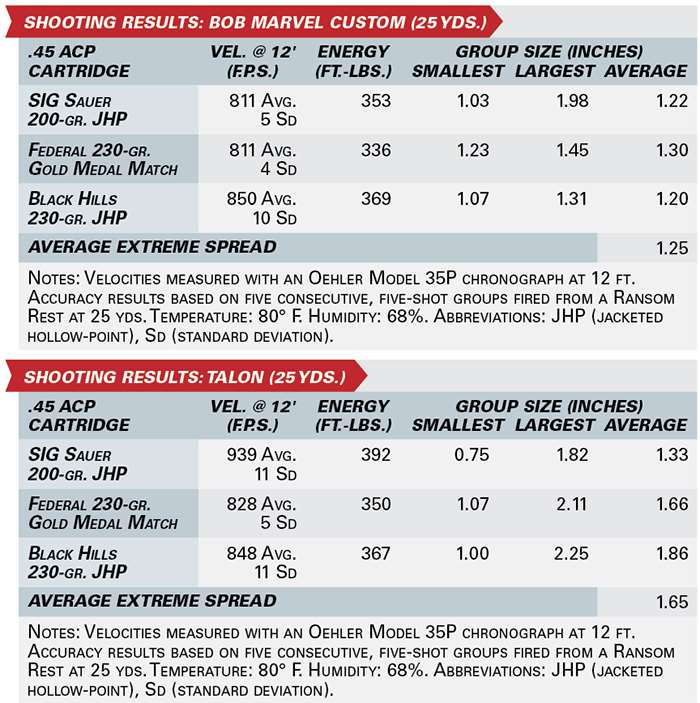
The results are tabulated above. Early Nighthawks were very accurate guns, and these latest products are just as good. With three different readily available commercial loads fired in American Rifleman’s protocol of five, five-shot groups, the two guns averaged 1.45" at 25 yds. The Bob Marvel Custom produced a 1.25" average, and the Talon came in at 1.65". This is exceptional performance, and many shooters would be well-served with such accuracy.
There’s no question that both Nighthawks are very fine guns featuring remarkable attention to detail. I only hope their prices don’t keep them out of the hands of folks whose duties send them into harm’s way.
